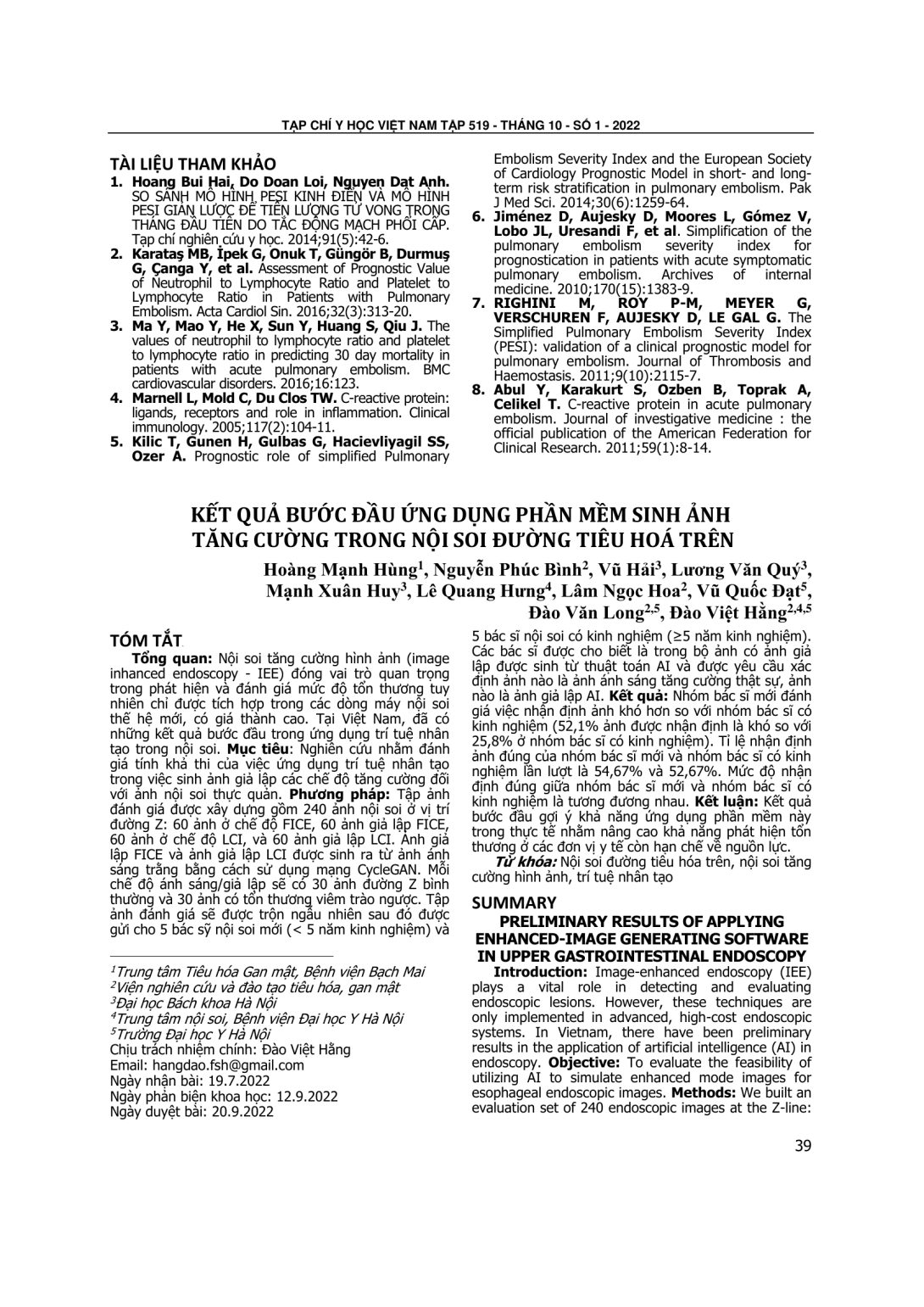
Nội soi tăng cường hình ảnh (image inhanced endoscopy - IEE) đóng vai trò quan trọng trong phát hiện và đánh giá mức độ tổn thương tuy nhiên chỉ được tích hợp trong các dòng máy nội soi thế hệ mới, có giá thành cao. Tại Việt Nam, đã có những kết quả bước đầu trong ứng dụng trí tuệ nhân tạo trong nội soi. Mục tiêu: Nghiên cứu nhằm đánh giá tính khả thi của việc ứng dụng trí tuệ nhân tạo trong việc sinh ảnh giả lập các chế độ tăng cường đối với ảnh nội soi thực quản. Phương pháp: Tập ảnh đánh giá được xây dựng gồm 240 ảnh nội soi ở vị trí đường Z: 60 ảnh ở chế độ FICE, 60 ảnh giả lập FICE, 60 ảnh ở chế độ LCI, và 60 ảnh giả lập LCI. Ảnh giả lập FICE và ảnh giả lập LCI được sinh ra từ ảnh ánh sáng trằng bằng cách sử dụng mạng CycleGAN. Mỗi chế độ ánh sáng/giả lập sẽ có 30 ảnh đường Z bình thường và 30 ảnh có tổn thương viêm trào ngược. Tập ảnh đánh giá sẽ được trộn ngẫu nhiên sau đó được gửi cho 5 bác sỹ nội soi mới (< 5 năm kinh nghiệm) và 5 bác sĩ nội soi có kinh nghiệm (≥5 năm kinh nghiệm). Các bác sĩ được cho biết là trong bộ ảnh có ảnh giả lập được sinh từ thuật toán AI và được yêu cầu xác định ảnh nào là ảnh ánh sáng tăng cường thật sự, ảnh nào là ảnh giả lập AI. Kết quả: Nhóm bác sĩ mới đánh giá việc nhận định ảnh khó hơn so với nhóm bác sĩ có kinh nghiệm (52,1% ảnh được nhận định là khó so với 25,8% ở nhóm bác sĩ có kinh nghiệm). Tỉ lệ nhận định ảnh đúng của nhóm bác sĩ mới và nhóm bác sĩ có kinh nghiệm lần lượt là 54,67% và 52,67%. Mức độ nhận định đúng giữa nhóm bác sĩ mới và nhóm bác sĩ có kinh nghiệm là tương đương nhau. Kết luận: Kết quả bước đầu gợi ý khả năng ứng dụng phần mềm này trong thực tế nhằm nâng cao khả năng phát hiện tổn thương ở các đơn vị y tế còn hạn chế về nguồn lực.
Image-enhanced endoscopy (IEE) plays a vital role in detecting and evaluating endoscopic lesions. However, these techniques are only implemented in advanced, high-cost endoscopic systems. In Vietnam, there have been preliminary results in the application of artificial intelligence (AI) in endoscopy. Objective: To evaluate the feasibility of utilizing AI to simulate enhanced mode images for esophageal endoscopic images. Methods: We built an evaluation set of 240 endoscopic images at the Z-line: 60 FICE images, 60 FICE-simulation images, 60 LCI images, and 60 LCI-simulation images. The FICE and LCI simulation images were generated from the white light images using the CycleGAN network. Each subset of images had 30 normal Z-line images and 30 images with reflux injury. The evaluation set was then shuffled and sent to five junior endoscopists (<5 years of experience) and five senior endoscopists (≥5 years of experience) for evaluation. The doctors were informed that there were simulated images generated by an AI algorithm in the image set and were asked to determine which images were IEE or AI-simulated images. Results: Compared to the senior doctors’ group, the junior doctors’ group assessed that image evaluation was more difficult (52.1% of images were considered hard to evaluate compared to 25.8% in the expert group). The rates of accurate evaluation in the junior group and the expert group were 54.7% and 52.7%, respectively. Ihe level of accurate evaluation between junior and senior doctors was similar. Conclusion: The preliminary results suggested the possibility of applying this software in clinical practice to improve lesions detection in medical units with limited resources.
- Đăng nhập để gửi ý kiến
